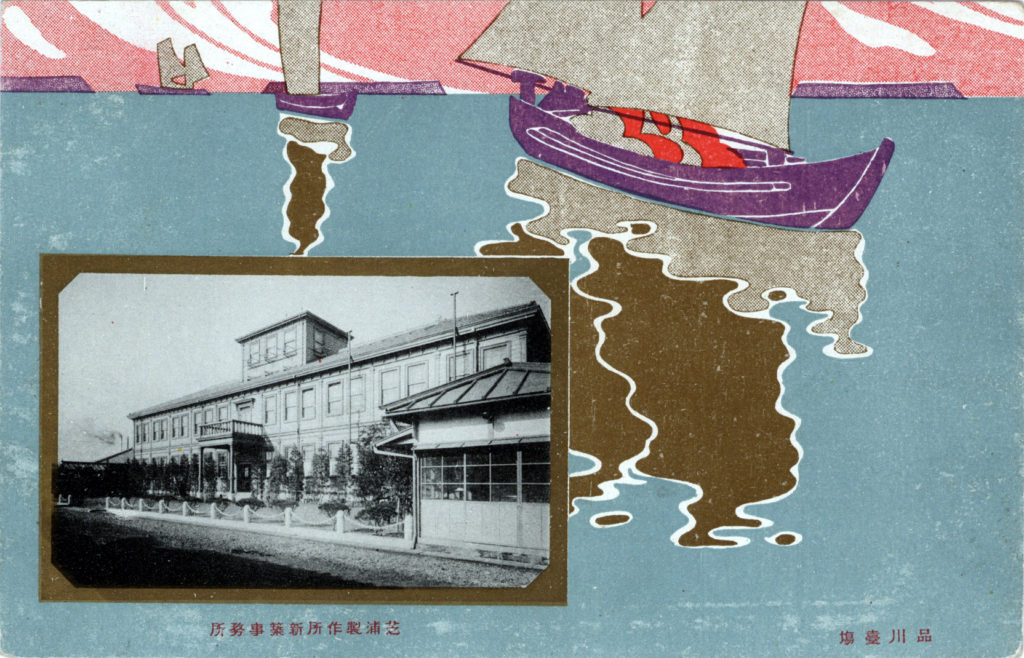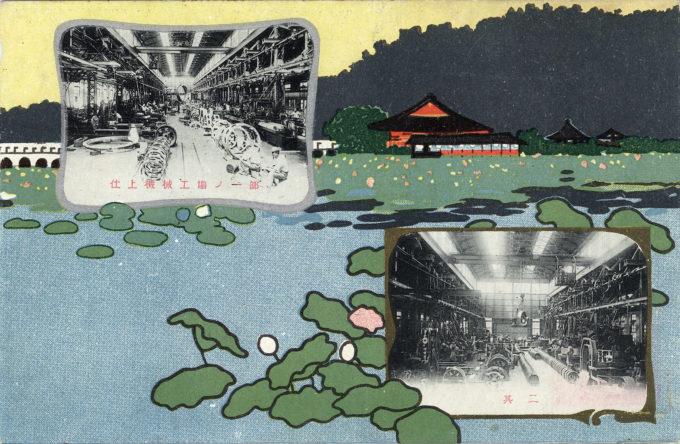
Shibaura Engineering Works, Shinagawa, c. 1910. General Electric (US) formed a joint-venture with the company in 1910, taking 1/3rd ownership. GE would also enter into a separate partnership with Tokyo Denki. Shibaura Engineering would later merge in 1939 with Tokyo Denki to form Toshiba.
See also:
Kyobashi (Capital Bridge), c. 1910.
Hitachi table fan, c. 1930.
“There are now fifteen or more large works in Japan constructing dynamos of over 1,000 kw., the largest being the Shibaura, the Hidachi, the Mitsubishi and the Okamura companies. Of these the Shibaura Engineering Works are undoubtedly the largest builders of electrical machinery.
“The history of this company dates back to 1875, when Mr. Hisashige Tanaka, a well-known organizer of that time, started a machine shop at Shibaura in Tokyo, under the name of the Tanaka Works. The enterprise was on a very small scale, but such as it was, it attained a high reputation for the excellence of its work. The shops were developed year by year to keep pace with the increasing demand for machinery, until in 1893 they came into possession of the Mitsui family, who changed the name to the Shibaura Engineering Works.
“The Russo Japanese war gave a strong stimulus to the works, which all this time specialized in the manufacture of electric generators, motors and transformers, in which the company’s experts made steady and commendable progress … Nearly every large engineering plant in Japan was supplied during that period with generators, water wheels, and boilers from the Shibaura Works.
“In 1910, the Shibaura Engineering Works made the step which brought it at once into prominence as the most advanced electrical concern in Japan and initiated that close cooperation with Americans which has since been the model for other American Japanese combinations. In this year, an arrangement was entered into with the General Electric Company of America for the use of their patents in Japan on a co-operative basis, in which the American company was allotted one third of the stock of the Japanese company.
“… Under such close and harmonious co-operation, the business of the Shibaura Engineering Works has increased to a point where it is now filling more than seventy per cent of the demand in Japan for electrical machinery and has extended its markets to China, Siam and the other Eastern Asiatic countries and islands. The decisive step taken in 1911 to confine itself to the development of electrical machinery and appliances was the turning point in its career of prosperity.
– The Far Eastern Review, November 1922
“In generators, switchboards, etc. there are a half-dozen fair sized factories, three of which can make generators of 7,500 to 12,500 kilovolt amperes. The Mitsubishi Co. is one of these; the other two are the Shibaura Engineering Works, and the Hidachi [Hitachi] Mining Co.
“The Shibaura Engineering Works near Tokyo is an old Japanese iron works that has been aided financially by an American electrical manufacturing company [General Electric] and that now makes a complete line of apparatus, very closely resembling the products of the American company … The Shibaura Engineering Works is the largest and best-equipped electrical manufacturing plant in Japan, turning out a broad line. In certain classes of work, parts are imported from the American manufacturer with which it is allied.
“Japanese engineers representing the Shibaura Engineering Works are at the plant of the allied company in the United States, and keep in close touch with new developments in design and manufacturing methods. There are no Americans in active management of the affairs of the Shibaura company but they appear in the directorate.
“… In electric fans, Japanese makers have done considerable business and are cutting into American trade in foreign markets. There are three or four manufacturers of importance and it is said that quite a number of small shops are taking up the work.
“The most important plant making fans is probably the Shibaura Engineering Works, which was said to have produced 30,000 fans in 1917 and to be planning a considerable increase in output during 1918. General details of this plant have been given earlier in this report, the company making a fan much like the American company [General Electric] with which it is allied. The Shibaura fans are said to be the best made in Japan.”
– “Electrical Goods in China, Japan, and Vladisvostok”, Special Agents Series #172, U.S. Department of Commerce, Bureau of Foreign and Domestic Commerce, 1918


